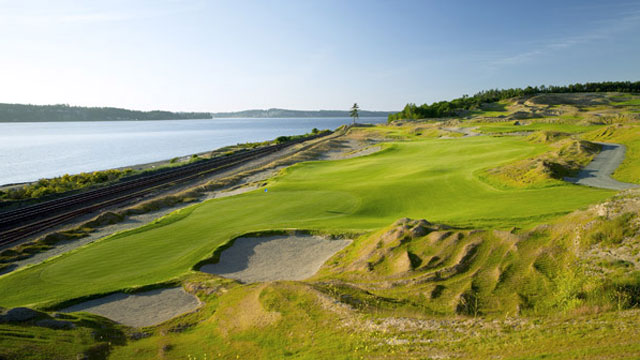NEWS
U.S. Amateur at Chambers Bay will serve as test run for 2015 U.S. Open
By Tim Booth
Published on

As Boris Stantchev dropped golf balls all over the 18th green and watched the crazy rolls caused by the contours, his playing companions tried to find an adequate comparison for what they just experienced playing Chambers Bay for the first time.
As he rolled yet another putt over a huge, brown mound on the green, Stantchev came up with perhaps the most appropriate comparison.
"This is straight out of St. Andrews," he yelled.
The links-style course that sits on the shores of Puget Sound has a long way to go to even be considered on the same driving range as the Scottish birthplace of golf. But this week serves as Chambers Bay's formal introduction to the golf world as host course for the U.S. Amateur.
With all due respect to the talented players in this week's tournament -- including defending champ Byeong-Hun An, current British Amateur champ Jin Jeong and eight players who qualified for the U.S. Open two months ago at Pebble Beach -- they are just a backdrop to the real story.
In many regards they will be considered a test study, to be re-examined five years from now when Chambers Bay serves as host for the U.S. Open.
"It was the same thing at Merion in 2005 and it's great. It's a privilege to be the test cases for the (Open)," said Morgan Hoffman, having just finished his sophomore season at Oklahoma State but playing in his fifth U.S. Amateur.
The tournament begins Monday with two rounds of stroke play to determine the 64 players that qualify for match play. One round will be played at Chambers Bay and one round will be played at The Home Course. All of match play will be contested at Chambers Bay.
And over the course of the next seven days, the United States Golf Association will learn all the ways Chambers Bay can be tricked out to get it ready for 2015.
While it's been lauded by reviewers and players alike, Chambers Bay has yet to face a formal test in tournament conditions. It's a little bit of a trip for those not used to a course with a heavy brown tint, hard and tight fairways and a reminiscent look of the British Isles.
"It just doesn't compare. Out there it's parkland courses that are tree-lined, relatively flat and the grass is obviously softer," said Stantchev, about to begin his sophomore year at Loyola Marymount. "I've never played on fescue grass like this before. Most of the grass we play out there is creeping and it's just different. You really can't compare it honestly."
Already, the course is set to be the longest for any USGA event. It will play nearly 7,750 yards, although with hard, slightly burned out fairways, it will seem substantially less.
Still, it's long -- more than six miles just to walk the 18 holes. And the unique nature of Chambers Bay's fescue add another dynamic that players must adjust to on top of the length.
Built atop an abandoned gravel quarry, the sandy base made creating a links course with a fecuse base an option. Designer Robert Trent Jones Jr. ran with that idea, using bulldozers to move earth and create massive dunes that frame many of the holes.
While most courses create tidy clumps of grass and earth when divots are created, shots at Chambers Bay turn into sandy dust clouds. Especially this week, when the fairways are being choked of water to make them concrete hard. The course also features uneven, rolling teeing grounds, sandy waste areas the size of housing developments and massive elevation changes that can give views of the entire course from the highest point.
Perhaps the most unique aspect of the course: In an area flooded with foliage, there stands just one tree.
"Where great land meets great water, great golf can happen," Jones said. "And in my view it did happen."
While the course provides panoramic postcard views of the Puget Sound and Olympic Mountains in the distance, there are concerns about the layout, especially the greens. Fescue greens are rare in the United States and the condition of those at Chambers Bay have come under question, to the point of continual rumors that the greens need to be replaced or the Open moved.
USGA Director of Rules and Competitions Mike Davis tried to put those rumors to rest during the U.S. Open at Pebble Beach in June, saying there was no chance the national championship would be moved from Chambers Bay.
"The one good thing about having the Amateur here," Davis said, "I'm expecting to learn a lot this coming August about June of 2015 on how the course is going to play."
